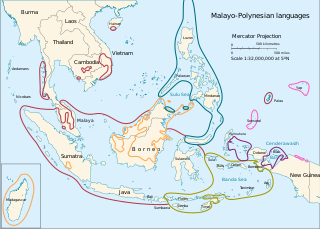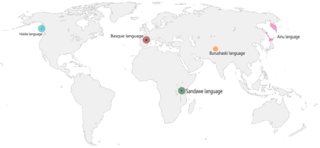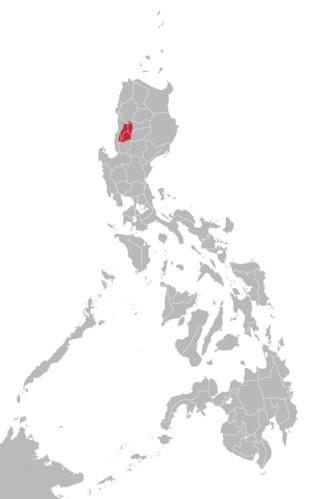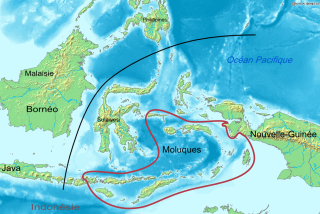Related Research Articles

The Malayo-Polynesian languages are a subgroup of the Austronesian languages, with approximately 385.5 million speakers. The Malayo-Polynesian languages are spoken by the Austronesian peoples outside of Taiwan, in the island nations of Southeast Asia and the Pacific Ocean, with a smaller number in continental Asia in the areas near the Malay Peninsula, with Cambodia, Vietnam and the Chinese island Hainan as the northwest geographic outlier. Malagasy, spoken on the island of Madagascar off the eastern coast of Africa in the Indian Ocean, is the furthest western outlier.

A language isolate is a language that has no demonstrable genetic relationship with any other languages. Basque in Europe, Ainu in Asia, Sandawe in Africa, Haida and Zuni in North America, Kanoê in South America, Tiwi in Australia and Burushaski in Pakistan are all examples of language isolates. The exact number of language isolates is yet unknown due to insufficient data on several languages.

Kankanaey is a South-Central Cordilleran language under the Austronesian family spoken on the island of Luzon in the Philippines primarily by the Kankanaey people. Alternate names for the language include Central Kankanaey, Kankanai, and Kankanay. It is widely used by Cordillerans, alongside Ilocano, specifically people from Mountain Province and people from the northern part of the Benguet Province. Kankanaey has a slight mutual intelligibility with the Ilocano language.
Tukang Besi is an Austronesian language spoken in the Tukangbesi Islands in southeast Sulawesi in Indonesia by a quarter million speakers. A Tukang Besi pidgin is used in the area.
The Yuat languages are an independent family of five Papuan languages spoken along the Yuat River in East Sepik Province, Papua New Guinea. They are an independent family in the classification of Malcolm Ross, but are included in Stephen Wurm's Sepik–Ramu proposal. However, Foley and Ross could find no lexical or morphological evidence that they are related to the Sepik or Ramu languages.
The Yalë language, also known as Yadë, Nagatman, or Nagatiman, is spoken in northwestern Papua New Guinea. It may be related to the Kwomtari languages, but Palmer (2018) classifies it as a language isolate.

Tause, also known as Doa or Darha, is a poorly-known Papuan language of Indonesia spoken by approximately 500 people, mainly in Derapos village.
Wetarese is an Austronesian language of Wetar, an island in the south Maluku, Indonesia, and of the nearby island Liran.

The Central Malayo-Polynesian languages (CMP) are a proposed branch in the Malayo-Polynesian subgroup of the Austronesian language family. The languages are spoken in the Lesser Sunda and Maluku Islands of the Banda Sea, in an area corresponding closely to the Indonesian provinces of East Nusa Tenggara and Maluku and the nation of East Timor, but with the Bima language extending to the eastern half of Sumbawa Island in the province of West Nusa Tenggara and the Sula languages of the Sula archipelago in the southwest corner of the province of North Maluku. The principal islands in this region are Sumbawa, Sumba, Flores, Timor, Buru, and Seram. The numerically most important languages are Bima, Manggarai of western Flores, Uab Meto of West Timor, and Tetum, the national language of East Timor.
Daasanach is a Cushitic language spoken by the Daasanach in Ethiopia, South Sudan and Kenya whose homeland is along the Lower Omo River and on the shores of Lake Turkana.

The Sama–Bajaw languages are a well-established group of languages spoken by the Sama-Bajau peoples of the Philippines, Indonesia, and Malaysia.

Larantuka Malay, also known as Nagi, is a Malay-based creole language spoken in the eastern part of Flores in Indonesia, especially in Larantuka. It is a derivative of Malay which is thought to originate from Malacca. It is a language with unspecified linguistic affiliation. According to 2007 data, this language is spoken by 20,000 speakers, mainly the people of East Flores. Larantuka Malay is the mother tongue of the Nagi people. Then it also functions as a second language for several nearby communities.
Ternate is a language of northern Maluku, eastern Indonesia. It is spoken by the Ternate people, who inhabit the island of Ternate, as well as many other areas of the archipelago. It is the dominant indigenous language of North Maluku, historically important as a regional lingua franca. A North Halmahera language, it is unlike most languages of Indonesia which belong to the Austronesian language family.
West Makian is a divergent North Halmahera language of Indonesia. It is spoken on the coast near Makian Island, and on the western half of that island.
Kwerba is a Papuan language of Indonesia. Alternate names are Airmati (Armati), Koassa, Mataweja, Naibedj, Segar Tor, Tekutameso.
Yonggom is one of the Ok languages of Indonesia and Papua New Guinea. According to its speakers, it is part of a continuum of 9 mutually intelligible dialects of Muyu languages which also includes Muyu, North Muyu (Kadi), South Muyu, and Ningrum. Petabahasa by Indonesian Ministry of Education classified this language as Yonggom/Yongkom(BPS:1158 6) spoken in Kampung Ninati, although another name recorded for South Muyu(BPS:0917 2) is Yongon.
Fordata is an Austronesian language spoken in the Tanimbar Islands of the Moluccas. It is closely related to Kei, and more distantly to Yamdena, both also spoken in the Tanimbar Islands.
Sinaugoro is an Austronesian language of Papua New Guinea. It is mainly spoken in the Rigo District of Central Province by some 15,000 people. The language is closely related to Motu.
Tondano is an Austronesian language spoken in the Tondano area of northeast Sulawesi, Indonesia. It is most similar to Tombulu and to Tonsea.
Luang, also known as Literi Lagona, is an Austronesian language spoken in the Leti Islands and the Babar Islands in Maluku, Indonesia. It is closely related to the neighboring Leti language, with 89% shared basic vocabulary.
References
- ↑ Selaru at Ethnologue (18th ed., 2015) (subscription required)
- ↑ Coward, David F. (2005). An Introduction to the Grammar of Selaru (PDF). SIL International.